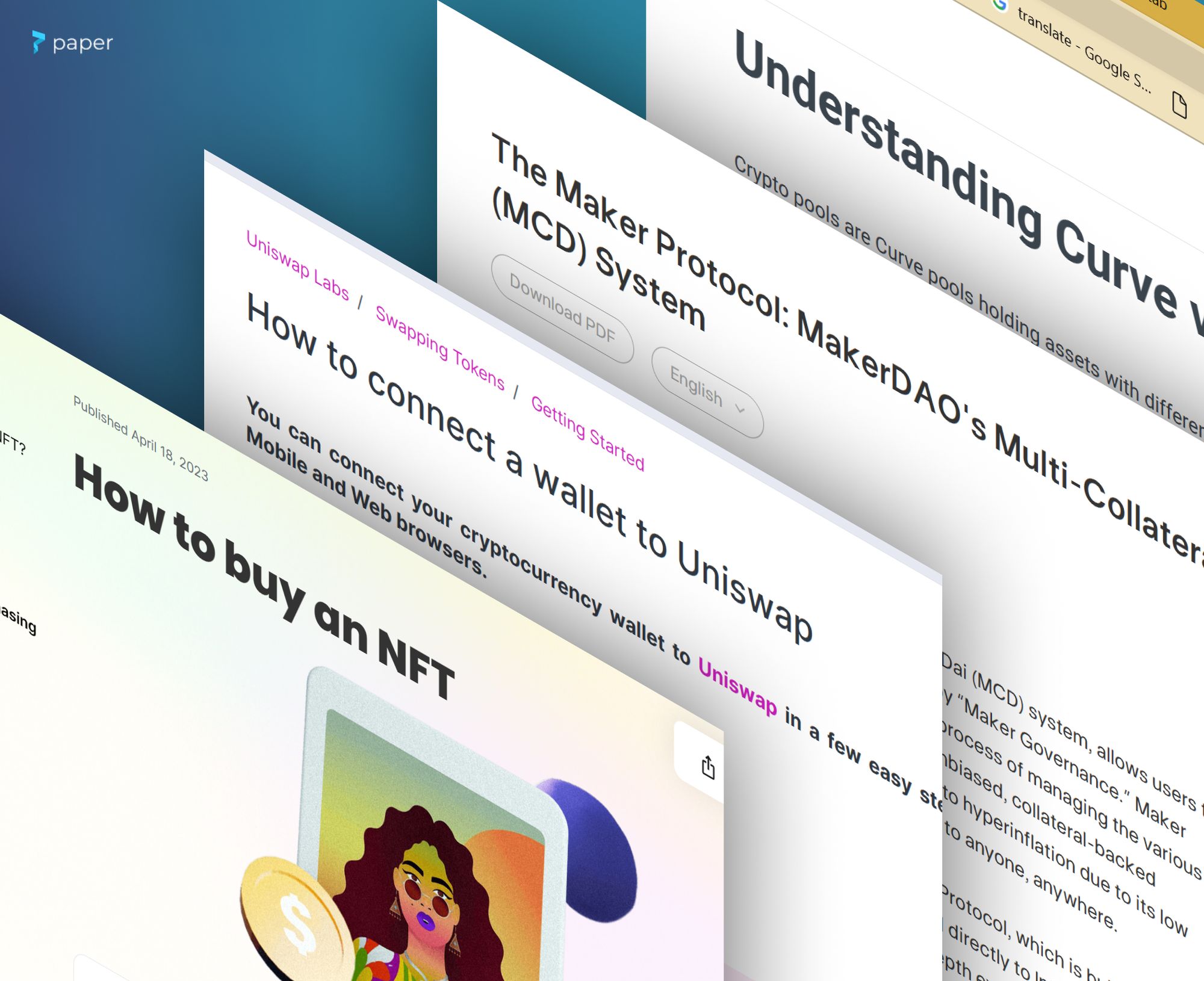How web3 reaches the next billion users

The Web3 Use Case
We’re at an inflection point for web3.
Until now, most of blockchain’s history has been a story of gradient descent. It’s been a series of experiments trying to find the ideal use case for blockchain technology. We’ve built millions of decentralized applications, many of which that were similar to their web2 counterparts - doing the same thing but with more steps involved.
In this process of experimentation, we’ve seen two major use-cases that are exclusively enabled by blockchain technology with broad appeal to global users: identity and liquidity.
Identity
Let’s start with identity. Today, our online identities are mostly stored within company databases. Facebook uses my browsing history to send me targeted mechanical keyboard ads, while YouTube fills my feed with cooking videos. Each platform has a siloed slice of my hobbies, interests, and values based on my interactions with that platform.
This information isn’t really an identity - it’s more of a profile, owned and utilized by the largest companies for profit.
That’s where crypto comes in. Collectors have flocked to NFT collections like BAYC, Azuki, and CryptoPunks, using profile picture NFTs as a way to express themselves and signal affiliation with distinct communities.
But identity is much more than what a person collects. It’s what they achieved, who they are, and how they see themselves. When someone spends money or time to earn a digital item that’s core to who they are, that should be a part of their digital identity. For example, if I reach masters within TFT, I should be able to show that off in other games like Honkai and Genshin.
To make that a reality, Riot Games would have to create and maintain player status APIs that other platforms can query. Then, miHoYo would need to integrate with Riot Games’ APIs. That interaction needs to happen across thousands of different platforms and services to build a comprehensive digital identity. Needless to say, it’s an infeasible amount of engineering work.
That’s where blockchain technology comes in. By providing interoperability on a global scale, it allows a person to gather a wide range of digital assets that ultimately represent their digital identity.
NFTs allow anything that can be represented as data to be uploaded to the blockchain. They can be digital collectibles from your favorite IP/brands, tickets to recent concerts/events, loyalty status from airlines/credit cards, and even licenses from artists/publishers. In other words, NFTs have the potential to represent your accomplishments, your interests, and your values.
This wide array of data, unified in a single place, enables a verifiable digital identity.
Liquidity
The second use case for Web3 is instant liquidity.
There’s a warehouse in Rotterdam that stores zinc and nickel. Traders from J.P. Morgan use the nickel in these warehouses as the basis for nickel contracts. For example, you could in theory buy 5 tons of nickel, and rather than taking delivery of the nickel, you take a “warrant” that states you own the nickel in the warehouse. You can then trade the nickel as if you had the nickel in your basement. When someone buys the nickel from you, they take ownership of the warrant rather than a truck loaded with 5 tons of nickel.
In large part, that’s how our current financial market works. There’s some level of trade that requires actual delivery of goods, but more often than not, it’s a process of trading warrants back and forth for price discovery.
The same concept can be applied to any mainstream collectible such as baseball cards, sneakers, clothing, toys, games, and even art. Any physical asset can be vaulted and tokenized into a digital asset.
This brings two main benefits. Like the nickel example, it’s often inconvenient for a physical collectible to be verified and shipped for each transaction. If a sneaker is damaged during transit, then that’s a net loss for both the buyer and seller. This constant shuffling is also labor-intensive, adding friction to the process in the form of platform fees and shipping costs.
Further, sellers are often locked into a single platform when selling their item. When listing on StockX, the seller has to physically ship the item to StockX - meaning that they now can’t access the buyers on eBay, GOAT, or Grailed.
Digital assets have no such problems. The transaction cost is exponentially lower than the sales process in physical goods, sellers have more liquidity in being able to access more buyers, and buyers have more price discovery with a larger selection of items.
So why hasn’t web3 taken off with these use cases & how do we solve it?
These two use cases have the potential to propel web3 to the next billion users. Yet, there are real obstacles in our path. Namely, crypto is really difficult to use and confidence is at an all-time low.
User Friction
Let’s start by looking at a basic use case: a buyer who’s new to the web3 ecosystem wants to purchase an NFT that might represent a digital collectible from their favorite IP.

A lot of web3 has just as many steps as it takes a new buyer to purchase an NFT. Users technically can accomplish what they want to do, but only at a cost of time and effort most aren’t willing to pay. Many times, decentralized applications end up writing pages of guides and FAQs to educate the user on how to use their product.

However, the solution here is not education but rather abstraction. Developers and projects have the responsibility and ability to make the friction from crypto invisible for their users. This includes removing gas fees by using relayers, removing private keys by assigning MPC wallets, and removing the onramp friction with integrations into credit card purchases.
The Problem of Trust
After a string of high-profile bankruptcies with Terraform Labs, Voyager, Three Arrows, FTX, BlockFi, Celsius, and Genesis, average consumers are wary of crypto. That means the only entry point for adoption is to tie together with non-crypto companies that have existing communities.
That’s what makes brands such as Nike, Mastercard, and Starbucks entering web3 so exciting. By making sizable investments in web3-based projects, these brands are lending their credibility to web3 while also bringing their audience to the space.

Further, as these projects are rolled out, consumers start to adopt web3 primitives. They start to set up wallets, collect NFTs, and learn more about the ecosystem. In doing so, the friction to trying new web3 applications dramatically decreases. It’s only a short distance for a Starbucks Odyssey member to list their new Siren Stamp on OpenSea or collect other NFTs.
And when Starbucks Odyssey members already have a wallet due to Starbuck’s NFT program, it becomes easier for companies to start launching their own web3 application. After all, the barrier to entry in setting up wallets is now minimized.
The other effect of brand adoption is the ability for crypto to become the standard of truth and digital identity for users. As a user’s Starbucks purchases to Nike workouts are documented, it becomes easier for them to accept their new digital identity. The more companies start to leverage blockchain, the closer we get to web3 powering true digital identities.
Paper and onboarding the next billion users
Our approach at Paper is to help developers build experiences where users can get the full benefit of crypto without having to learn about the complexities of the technology.
Today, projects need relayers to remove gas fees, a fleet of wallets to enable credit card minting, a fraud detection engine for compliance, and an authentication service with key management to abstract the use of private keys.
In theory, it’s possible to string together 8-10 different tools that each solve a problem on the list. In practice, this suite of tooling slows teams down, forcing them to spend time on integrations rather than building out user value.
Paper provides the developer platform that tackles the end to end user experience of crypto abstraction. Our NFT Checkouts cover wallet infrastructure, gasless relayers, fraud, and onramp. Our Embedded Wallet Service covers auth, gasless relayers, and data query APIs needed to turn wallets invisible.
At the end of the day, web3 needs infrastructure for developers and brands to build web3 products that meet web2 users where they are. This infrastructure needs to decrease the friction for the average user and enable web2 brands to bring their existing communities to crypto.
Only then can we start to see crypto’s interoperability power identity and liquidity use cases where traditional databases fall short and onboard the next billion users.


